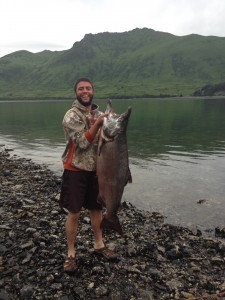I recently voyaged to Annapolis, Maryland, to attend the 72nd Annual Northeastern Fish and Wildlife Conference. This conference was a collection of members from state fisheries and wildlife agencies, conservation officers and wardens, university researchers and professors, private consulting firms, graduate and undergraduate students. At first I assumed I was going to be the low man on the totem pole, but after conversing with some professionals and attending the presentations, I did not feel completely removed from these individuals. I was expecting to sit in on presentations I didn’t completely understand, but as a senior in Wildlife Sciences I found myself able to make sense of the vast majority of the presentations and provide concerns I had about their methodology and the implications of their research. It was reassuring to find that many I spoke with had experienced the same turmoil that I am in dealing with the last few weeks of their senior year, stress in finding a job after graduation, and planning what they were going to do with themselves with life after school. This definitely strengthened my belief that I was pursuing a career in the right field.
Ten students in the STEM (Science Technology Engineering Mathematics) program at Paul Smith’s attended this conference. STEM is a scholarship program funded by the National Science Foundation with the intention of preparing students for careers in the scientific community by building valuable research experience, networking with professionals, and creating a solid foundation to conduct “good science.” This year’s group project was based on bird mortality from collisions with windows. I’m sure many of you reading this have experienced a bird colliding with a window at your house, place of work, or here at Paul Smith’s. Many times the bird will be confused for a little bit and then fly off, but there are those occasions where such a collision is fatal. The aim of this project was to determine the frequency of such an event at buildings in a rural landscape, like we see at Paul Smiths, and explore possible methods to reduce the rate at which birds collide with windows. Much of the past year has been spent reviewing literature on the topic, developing our study goals and objectives, forming solid methods to reduce the levels of ambiguity surrounding the issue, and begin to analyze some of the data we have already collected.
A member from our group, Grace Mayhew, gave a presentation at the conference that focused on our exploratory study of bird-window collisions. The presentation room was filled with professionals from all areas of the wildlife sciences community (more audience members than many of the other presentations) and she did an excellent job presenting what we have been doing since late August, 2015. We encouraged feedback from those professionals in the audience, and it was comforting to know that many of the concerns they brought up were also our concerns. We also heard ideas from professionals that we had not even considered. It was an excellent opportunity to be able to receive feedback from those who have spent a lot of time working in the field and who have amassed a great amount of experience in similar topics. I think it was very encouraging that all of the debating that took place within our group in the beginning of our project is something that occurs at a professional level. It was definitely a great experience to encounter some of the same frustrations that research scientists, wildlife and fisheries biologists, and other professionals have to deal with all the time in their work.
Two solid days of attending 20-minute presentations on topics was definitely a handful. The topics ranged from nesting behavior of small songbirds to the problems related with public opinions of wildlife and fisheries managers, to restoration of trout habitat in small streams, to a plenary speaker who talked about how he used a stuffed wood duck to launch the social media presence of the Bangor, ME police department. The diversity of presentations topics allowed for each of the students to attend talks that were more interesting to them. Many of the students took the opportunity to have a professional take them out for lunch and gain insight from someone who is a part of the professional field. I accompanied someone from the Brookhaven National Laboratory Facility in Long Island, NY. It was a great chance to meet with a professional and have a serious discussion about what the fisheries and wildlife field is all about. He told me of all the jobs and experiences he had leading up to his current position and gave me invaluable advice on how to get ahead in the field and be competitive. It was really nice to talk with a professional at a personal level and the free meal was another nice perk.
I had a great time attending this conference, attending a variety of presentations, and talking with professionals. It also helped that the nice weather gave me a break from the brisk winds of the Adirondacks. The biggest thing that I took away from the conference was the reassurance that most of the professionals went through the same stressful periods in their life that I am experiencing now. It provided me even more motivation to succeed in this field and make something of myself. Other than that, my favorite memory would have to be the Sunday brunch that consisted of huge French toast stuffed with peach and white chocolate cheesecake with whipped cream and maple syrup. The presentations after consuming that monster are a little more blurry in my mind than others…

My name is Joe Faryniarz and I am a senior in the Wildlife Sciences Program. I am graduating in the spring and I hail from across the pond in that small state that a surprising amount of people think is part of Canada. I enjoy being outside and frolicking in the woodlands where some say I resemble Donnie from The Wild Thornberry’s.


